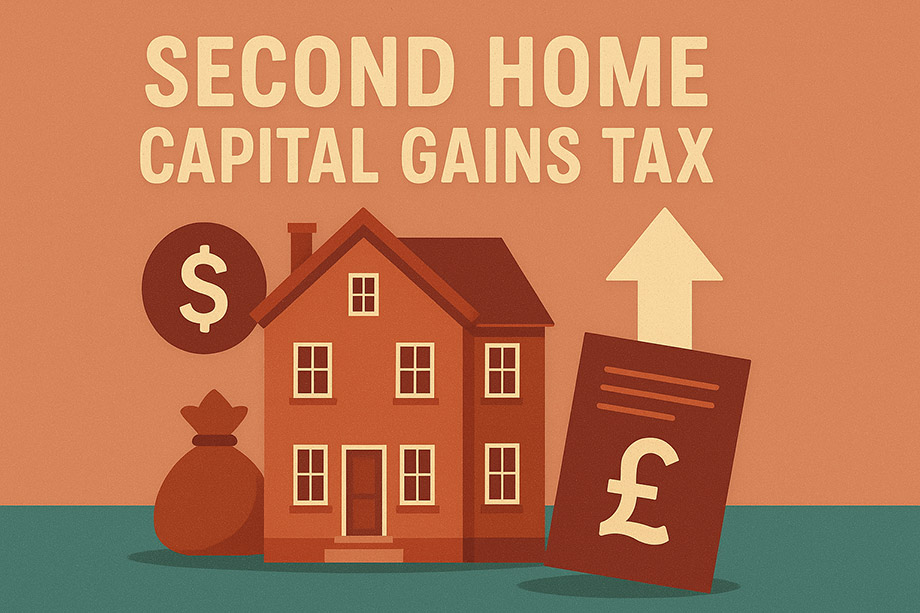The Complete Second Home Capital Gains Tax Strategy Guide – Beyond the Basics

While most property owners know they’ll face capital gains tax when selling a second home, the real challenge lies in understanding the strategic decisions that can significantly impact your tax liability. This comprehensive guide moves beyond basic rate explanations to provide actionable strategies for minimizing your CGT burden.
Understanding the Current Landscape
The UK currently charges capital gains tax at 24% for higher rate taxpayers and 18% for basic rate taxpayers on second home sales, following the reduction from 28% that took effect in April 2024. However, focusing solely on these rates misses the bigger picture of tax planning opportunities.
Strategic Timing: The Art of the Tax-Efficient Sale
The Annual Allowance Window
Each taxpayer receives a £3,000 annual CGT allowance for 2025-26, meaning couples can potentially shelter £6,000 of gains from tax. Smart property sellers coordinate their disposals to maximize this allowance across multiple tax years.
Strategy: If your expected gain exceeds the annual allowance, consider delaying completion to the following tax year, effectively doubling your tax-free threshold over two years.
Income Tax Band Optimization
Many property owners overlook how capital gains interact with their existing income. Capital gains are added to your other income when determining which tax bracket applies, potentially pushing you from the basic rate (18%) into the higher rate (24%) threshold.
Strategy: Time your property sale for a year when your other income is lower, such as early retirement or between jobs, to benefit from the reduced 18% rate.
Advanced Deduction Strategies
The Enhancement vs. Repair Distinction
While you can deduct costs for property improvements like extensions, you cannot deduct general maintenance and upkeep costs. Understanding this distinction can save thousands in tax.
Qualifying enhancements include:
- Kitchen or bathroom renovations that add value
- Loft conversions or extensions
- Central heating installation
- Double glazing replacement
Non-qualifying expenses:
- Routine maintenance and repairs
- Redecorating existing rooms
- Garden maintenance
- Replacing like-for-like items
Professional Fees and Transaction Costs
Legitimate costs involved with buying and selling the property, including broker fees and stamp duty, can be deducted from your gain. Ensure you retain all documentation for:
- Estate agent fees
- Solicitor costs
- Surveyor fees
- Mortgage arrangement fees (original purchase)
- Stamp duty paid on purchase
The Partial Residence Relief Opportunity
One of the most overlooked strategies involves properties that were once your main residence. You won’t need to pay CGT for periods when the property was your main residence, plus an additional nine months of ownership even if you weren’t living there.
Practical application: If you lived in your second home for three years out of ten years of ownership, you’ll only pay CGT on seven years of gain (minus the nine-month grace period).
Joint Ownership Tax Planning
Transferring Between Spouses
You do not usually need to pay tax on gifts to your spouse or civil partner. This creates significant planning opportunities for couples.
Strategy: Before selling, consider transferring a portion of the property to your spouse if they’re in a lower tax bracket or have unused annual allowances.
Timing Completion vs. Exchange
For UK properties, you must pay CGT within 60 days of completion, not exchange. This timing difference can be crucial for tax planning, especially when completion crosses tax years.
Loss Relief Planning
You can offset losses from other asset sales against property gains, and claim losses up to four years after they were incurred. This often-overlooked strategy can substantially reduce your CGT liability.
Strategy: Review your investment portfolio before selling property. Realizing losses on underperforming investments can offset your property gains.
The Multiple Property Strategy
For investors with multiple properties, the order of sales can significantly impact total tax liability. Consider:
- Sequencing sales to optimize annual allowances
- Bundling smaller gains within a single tax year
- Spreading larger gains across multiple years
- Using losses from one property to offset gains from another
Inheritance and Gift Planning
Living Gifts vs. Death Transfers
Properties inherited at death receive a “stepped-up basis” at market value, while lifetime gifts retain the original purchase price for CGT purposes. This creates complex planning considerations for family wealth transfer.
Key consideration: A property worth £300,000 inherited at death versus the same property gifted during lifetime can result in dramatically different CGT liabilities for the recipient.
Common Pitfalls to Avoid
The Business Relief Trap
You may get tax relief if the property is a business asset, but this relief has specific conditions that many property investors misunderstand.
Nomination Timing
You have two years from acquiring a new home to nominate which property will be tax-free for CGT purposes. Missing this deadline can result in unexpected tax liabilities.
The 60-Day Rule
The requirement to pay CGT within 60 days of completion catches many sellers off-guard, particularly when dealing with complex calculations or disputes over the gain amount.
Planning for Future Changes
Tax legislation continues to evolve. The recent reduction in property CGT rates was estimated to increase property transactions by approximately 2%, but future governments may reverse these changes.
Future-proofing strategies:
- Maintain detailed records of all property-related expenses
- Consider timing of major improvements to maximize deductible costs
- Review your property portfolio annually for optimization opportunities
- Keep abreast of proposed legislative changes
Conclusion
Effective capital gains tax planning for second homes requires looking beyond basic rate calculations to understand the full spectrum of available strategies. By implementing proper timing, maximizing deductions, and coordinating with overall tax planning, property owners can significantly reduce their CGT liability while remaining fully compliant with HMRC requirements.
The key is to plan early and seek professional advice when dealing with complex situations or substantial gains. The cost of professional tax planning often represents a fraction of the potential savings available through strategic CGT management.
This guide provides general information and should not be considered as specific tax advice. Individual circumstances vary, and professional consultation is recommended for complex situations.
Last Updated on July 23, 2025 by James Cartwright







